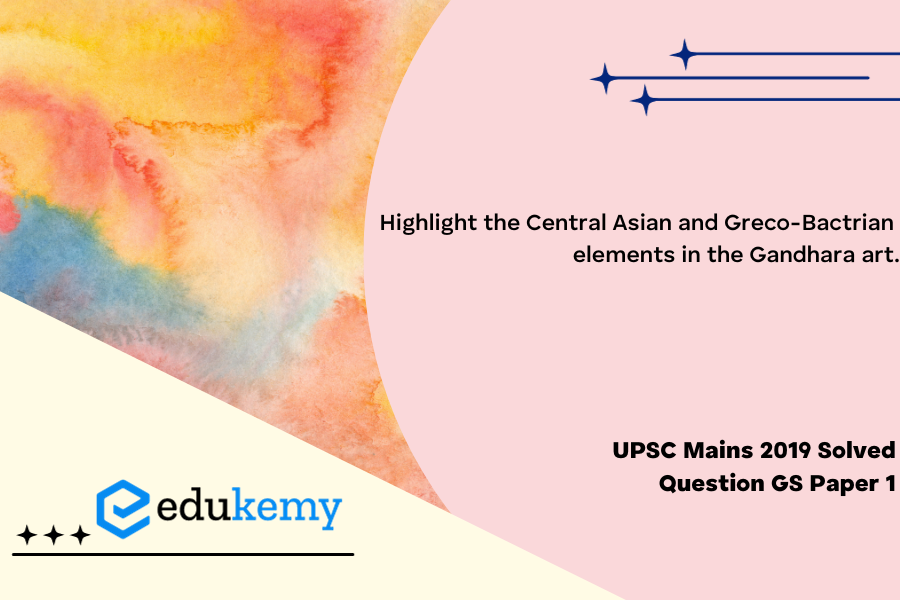Gandhara art, a unique fusion of Hellenistic and indigenous artistic traditions, flourished in the Gandhara region, encompassing parts of present-day Pakistan and Afghanistan, from the 1st to 5th centuries CE. This artistic phenomenon is a testament to the cross-cultural exchange between Central Asia and the Greco-Bactrian kingdoms, which left an indelible mark on the visual aesthetics of the region. Central Asian elements in Gandhara art are evident in the portrayal of figures, often with distinct facial features and attire reminiscent of nomadic Central Asian cultures. Meanwhile, the Greco-Bactrian influence manifests in artistic techniques, such as the use of realistic anatomy, drapery, and architectural motifs reminiscent of Hellenistic traditions. The synthesis of these diverse elements in Gandhara art not only reflects the rich cultural amalgamation in the region but also highlights the sophistication of the artistic synthesis that occurred at the crossroads of Central Asia and the Hellenistic world.
Tag: Art and Culture.
Contents
Decoding the Question:
- In the Introduction, try to briefly write about the emergence of Gandhara art.
- In Body,
- Write various Central Asian and Greco-Bactrian elements in the Gandhara art.
- In Conclusion, try to write about the overall significance and impact of Gandhara art.
Answer:
Gandhara School of Art was one of the major schools of art in the history of ancient India. Although being an intricate part of Indian history, it is uniquely associated with the Greco-Roman style of art. The combination of these Greco-Roman and Indian ideas along with the influence of other foreign traditions such as from Central Asia, Iran, and China resulted in the formation of a distinct style known as the Gandhara School of Art. It flourished from the 1st century BCE to 4th century CE in the North west part of India and came under the political influence of the different kingdoms like Greco- Bactrians, Pratihars, Kushanas, Shakas, etc. which resulted in the emergence of a mixed school of arts.
Central Asian and Greco-Bactrian elements in the Gandhara art:
- Representation of Buddha: Gandhara art depicts Buddha in a more humanized form with Greek-inspired facial features, such as wavy hair, a well-defined forehead, and a distinct nose. The depiction of Buddha in a standing or seated pose with a flowing robe, reminiscent of Greek attire, showcases the Greco-Bactrian influence on the artistic representation of the spiritual figure.
- Iconography and Symbols: Gandhara art incorporates Greek iconographic elements, such as the depiction of Buddha with the Greek god-like contrapposto posture, where the weight of the figure rests on one leg. The use of floral and vine motifs, common in Greco-Roman art, can be observed in Gandhara sculptures, especially in the decoration of pillars and architraves.
- Drapery and Clothing: The rendering of drapery and clothing in Gandhara art displays a blend of Central Asian and Greek styles. The flowing garments and intricate folds reflect Central Asian influences, while the Greek influence is evident in the sculptural portrayal of realistic drapery.
- Corinthian Capitals: The use of Corinthian-style capitals, characterized by acanthus leaves and intricate floral patterns, is a notable Greco-Bactrian architectural element in Gandhara art. These capitals adorned the pillars of Gandharan stupas and monasteries.
- Hellenistic Motifs: Hellenistic motifs, such as winged cupids (Erotes), centaurs, and cherubs, appear in Gandhara art, blending Greek mythological themes with Buddhist iconography. The use of Greek-style architectural ornamentation, including Corinthian columns, pilasters, and friezes, demonstrates the incorporation of Greco-Bactrian architectural elements in Gandhara structures.
- Narrative Panels: Gandhara sculptures often feature narrative panels depicting scenes from the life of Buddha and other Buddhist deities. These panels showcase the influence of Central Asian and Greco-Bactrian artistry in storytelling and iconography.
- Influences on Bodhisattva Figures: Bodhisattva figures in Gandhara art exhibit influences from Greco-Bactrian representations of Hellenistic deities. The incorporation of youthful and idealized features in Bodhisattva images reveals the impact of Greco-Bactrian aesthetics.
- Apsaras and Celestial Beings: Apsaras and other celestial beings depicted in Gandhara art show influences from both Central Asian and Greco-Roman artistic traditions, contributing to the celestial ambiance of Buddhist narratives.
There was massive use of black stone and stucco, which was a type of plaster used for many structures including the freestanding ones under this style of art. The free-standing structures included many chaityas, Viharas, and stupas. The striking feature of the Gandhara School of Art shows a very realistic and natural depiction of features in perfection.
Though Gandhara art has been influenced by Central Asian and Greco-Bactrian elements it emerged as a unique art form in India also. Because of its strategic geographical position, the region became a meeting place of cultures. These techniques were endured till the epoch of Gupta. Gupta’s realistic anthropomorphic representations of the Buddha reflect the legacy of the Gandhara artistic influence.

In case you still have your doubts, contact us on 9811333901.
For UPSC Prelims Resources, Click here
For Daily Updates and Study Material:
Join our Telegram Channel – Edukemy for IAS
- 1. Learn through Videos – here
- 2. Be Exam Ready by Practicing Daily MCQs – here
- 3. Daily Newsletter – Get all your Current Affairs Covered – here
- 4. Mains Answer Writing Practice – here


